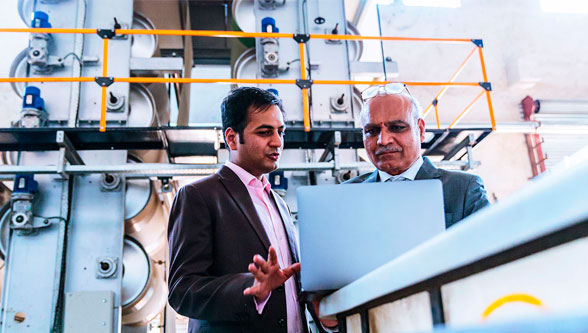Plant maintenance teams know the value of time. They are under continual pressure to minimize downtime, speed resolution rates, and streamline preventive maintenance, keeping interruptions to work-cycles as brief as possible. The need for speed is the one factor common to the wide range of work orders that may be assigned to a plant maintenance technician. Remote connectivity and mobile solutions play an essential role in meeting expectations for speed. They give technicians access to data when and where they need it most – in the field. This helps make informed decisions quickly.
Maintenance technicians seldom sit at a desk or work station. They are on the go, often to remote or dangerous locations. They climb towers, crouch on cat-walks ten stories high, crawl to the backside of furnaces and generators, and venture to rooftops in rain and snow to inspect air handling units. They may start and end their shift at the office, checking in on team priorities or communicating with colleagues, but a highly productive technician is more likely to be found in the heart of the operations.
And, yet, remote connectivity isn’t always guaranteed. Equipping field technicians with robust mobile solutions is sometimes an afterthought, or a low-priority line item. Initiatives can also be delayed because of budget constraints. Numerous other issues can get in the way of rolling out an effective mobile strategy. Debates about type of hardware to select, security concerns, controlling remote access, and how to convert highly complex data into small screens are among the common challenges plant maintenance departments face.
Challenges and Solutions
All of the common challenges have solutions. The benefits of remote connectivity and access to data far outweigh the time and costs of overcoming hurdles to deployment. Here are five common issues and corresponding solutions:
- Devices. Choosing the right type of mobile device is essential. The mobile device, whether a smart phone, laptop, tablet, or wearable device, needs to provide the ease-of-use and durability to match the environment in which it will be used, the type of technician who will be using it, and any physical considerations. For example, if technicians will likely be wearing gloves and working in areas with high temperature and humidity, devices with large keypads and heat/moisture resistance will be essential.Some companies opt for the Bring Your Own Device (BYOD) strategy, which means asking technicians to use their own smart phones or tablets. But, most enterprises are finding this adds complications, such as how to compensate the technician if the device is lost or damaged while on the clock. Personal devices may also be more vulnerable to security breaches and pose extra work for the IT team as they are asked to support numerous brands and platforms. Assigning one type of device to all technicians simplifies the support process, creates a consistent user experience across the whole team, and gives the organization more control over security.
- Usability. Besides matching the physical specifications appropriate to the need, the software solution also must meet business user expectations. If the solution is cumbersome to navigate, confusing, hard to personalize for specific needs, or lacks relevant help tools and knowledge bases, the technician is less likely to be an active user who leverages capabilities and makes the most of information available. When usability is lacking, technicians are less productive, wasting time hunting for answers, stumbling through awkward navigation, and clicking through numerous irrelevant screens. Poorly designed solutions can even hurt recruitment and retention of technicians—highly valuable personnel.
- Reliability. Some mobile solutions on the market were not built with mobility in mind; they ask the user to access the system through a web portal without creating responsive screens that will adapt to the size of the device. This means a technician may need to view massive amounts of information through a small window or contend with tiny text and distorted images. If mobile solutions don’t consolidate or simplify usability, users will create their own shortcuts, often resulting in imperfect data. For example, if the technician must scroll through 500 possible resolution codes, it’s quite possible the technician will simply pick “Miscellaneous” every time. It will speed the process—but compromise reliability of data. Instead, look for a solution that is built for mobility, highly responsive, and that tailors screens for the specialized needs of mobile access.
- Compliance. Whether the mobile solution saves data in real time or synchronizes at the end of the day can cause compliance issues. Many mandates require activities to be tracked by when the asset is serviced or repaired, not when the data is uploaded to the system. For companies in industries with strict compliance needs, this will be an important functionality to verify. Every industry has specialized demands. Only software providers that focus on industry functionality will have the mobile solutions that align well.
- Security. Safe-guarding data security is one of the classic issues brought up when skeptics voice concerns about mobile solutions. Some managers may worry that several mobile accounts accessing the system can make the system vulnerable. However, if the mobile solution is a natural extension of the main solution, requiring the same type of secure login, then the mobile accounts have the same level of security. Access is also controlled so personnel only access the data they are authorized to use. Modern mobile solutions are highly secure.
Concluding thoughts
As enterprises focus on improving reliability of plant assets, attention turns to the productivity of maintenance technicians. Equipping technicians with mobile devices is an important way to give them the information they need to make well-informed decisions. With up-to-the-moment information about parts inventory, scheduled upgrades, and long-term demands of the asset, the technician can make sound decisions about replacing or repairing the asset. But, the right type of mobile device—and the right software solution—must be in place for the strategy to be truly effective. Multiple factors should be considered, from the type of user to the ease of use. Most importantly, mobile solutions can’t be an after-thought. Take time to think through the strategy and deploy the smart solution for the job.
Article by Ranga Pothula, Managing Director, Infor
Ranga Pothula is the Managing Director for Infor’s India Business Unit. At Infor, his responsibility is scaling IBU operations by sharpening focus on global delivery, servicing offerings, technology developments, and strengthening customer and partner relations. Ranga has been at Infor for over two decades. Having been at the helm of both R&D and CoE services across multiple products, under his charge, he has been leading the growing global delivery services operations in India, the Philippines, Egypt and Poland over the past four years





